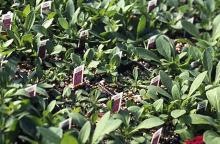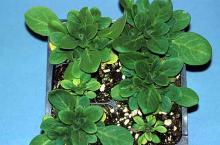See:
Greenhouse Plants, Ornamental - Black Root Rot
Cause Berkeleyomyces sp. (formerly Thielaviopsis basicola) a soilborne fungus (long-lived in soil without a susceptible host) with a wide host range including Alyssum, begonia, cyclamen, geranium, marigold, petunia, phlox, poinsettia, primula, snapdragon, sweet pea, and verbena. Plants are susceptible at all growth stages. In general, the disease is favored by high soil moisture content (particularly greater than 70%), high pH (greater than 6.5), and cool soils (55°F to 70°F). Spores can survive longer than 12 months in some soils.
Symptoms Lower leaves of infected plants turn yellow. Plants are stunted, and severely infected plants die. Infections usually start at root tips and through root hairs. Root discoloration initially is brown and becomes a dark, flat black as abundant chlamydospores form on and in the root. This blackening may extend from the roots into the crown and lower stem. Rots tend to be firm instead of soft and mushy as with Pythium. The roots of infected plugs often fail to grow beyond the original plug after transplanting. Symptoms are often not expressed until plants are subjected to unfavorable environmental conditions. All ages of plants can be affected. Within a planting there might be an uneven stand or random pattern of healthy appearing and stunted plants.
Cultural control Sanitation is very important.
- In the greenhouse:
- Use soilless potting media or sterilized soil. Steam soil for 30 min. at 180°F.
- Use new or sterile pots and trays. Avoid reusing pots and trays. If reusing, thoroughly remove organic matter and soil, then wash with a disinfectant such as a 10% bleach solution or treat them with aerated steam at 122°F for 30 min.
- Keep soilless media pH on the acidic side, ideally from 5.5 to 6.0. Note that petunias tend to naturally increase the growing media pH.
- Remove and discard all diseased plants; be careful not to contaminate adjacent plants.
- Control fungus gnats and shore flies, which spread viable spores on their bodies and in their feces. Consult the PNW Insect Management Handbook for current control tactics.
- After the production cycle, remove any remaining plants and disinfect the section.
- In the landscape:
- Plant only clean, pathogen-free plants in well-drained areas. Improve drainage if needed.
- Remove severely infected plants.
- Rotate planting beds if replanting annually.
Chemical control Fungicides work best when used as a protectant in combination with cultural controls. Chemical control may require multiple applications. If the disease is noticed early, also treat with fungicides. Plants that develop good root systems before winter often tolerate the disease. Fungicides will not work well when the disease is severe. This pathogen can be difficult to control, and often the higher rate is more effective.
- Avelyo at 2 to 3 fl oz/100 gal water. Group 3 fungicide. 12-hr reentry.
- Banrot 40 WP at 4 to 8 oz/100 gal water applied to 800 sq ft of bed area. Group 1 + 14 fungicide. 12-hr reentry.
- Broadform at 2 to 4 fl oz/100 gal water. Do not drench. Group 7 + 11 fungicide. 12-hr reentry.
- Empress at 1 to 6 fl oz/100 gal water. May discolor blooms that are open during application. Group 11 fungicide. 12-hr reentry.
- Medallion WDG at 1 to 2 oz/100 gal water. Using with oils or adjuvants may damage plant. Use as protectant before symptoms occur since it is ineffective once plants are infected. Group 12 fungicide. 12-hr reentry.
- Mural at 2 to 3 oz/100 gal water used as a drench. Group 7 + 11 fungicide. 12-hr reentry.
- Spirato GHN at 1 to 2 fl oz/100 gal water. Use with oils or adjuvants may cause plant damage. Group 12 fungicide. 12-hr reentry.
- Terraguard SC at 2 to 8 fl oz/100 gal water. Group 3 fungicide. 2-hr reentry.
- Thiophanate-methyl-based products. Higher rates have resulted in better control. Group 1 fungicides. 12-hr reentry.
- Cleary's 3336 EG at 8 to 16 oz/100 gal water.
- OHP 6672 4.5 F at 7.5 to 20 fl oz/100 gal water.
Note: Some registered products offer only suppression of this disease and thus are not recommended for use. These products include Orkestra.
Biological control Use in conjunction with other control tactics.
- LALStop K61 WP (Streptomyces Strain K61) at 0.07 oz/100 to 200 sq ft. Apply with enough water to move product into the root zone. Can be used as a soil spray, drench, dip or incorporated into potting media. 4-hr reentry. O
- Mycostop (Streptomyces Strain K61) at 1 to 2 g/100 sq ft. Apply with enough water to move product into the root zone. Can be used as a soil spray, drench, dip or incorporated into potting media. 4-hr reentry. O
References Hausbeck. 2015. Evaluation of drench applications of registered and experimental fungicides for the control of Thielaviopsis root rot on petunia, 2014. Plant Disease Management Reports, 11, OT026.
Hand, F. P and Bellizzi, M. 2017. Evaluation of fungicides for the control of black root rot on petunia plugs, 2017. Plant Disease Management Reports, 11, OT026.



